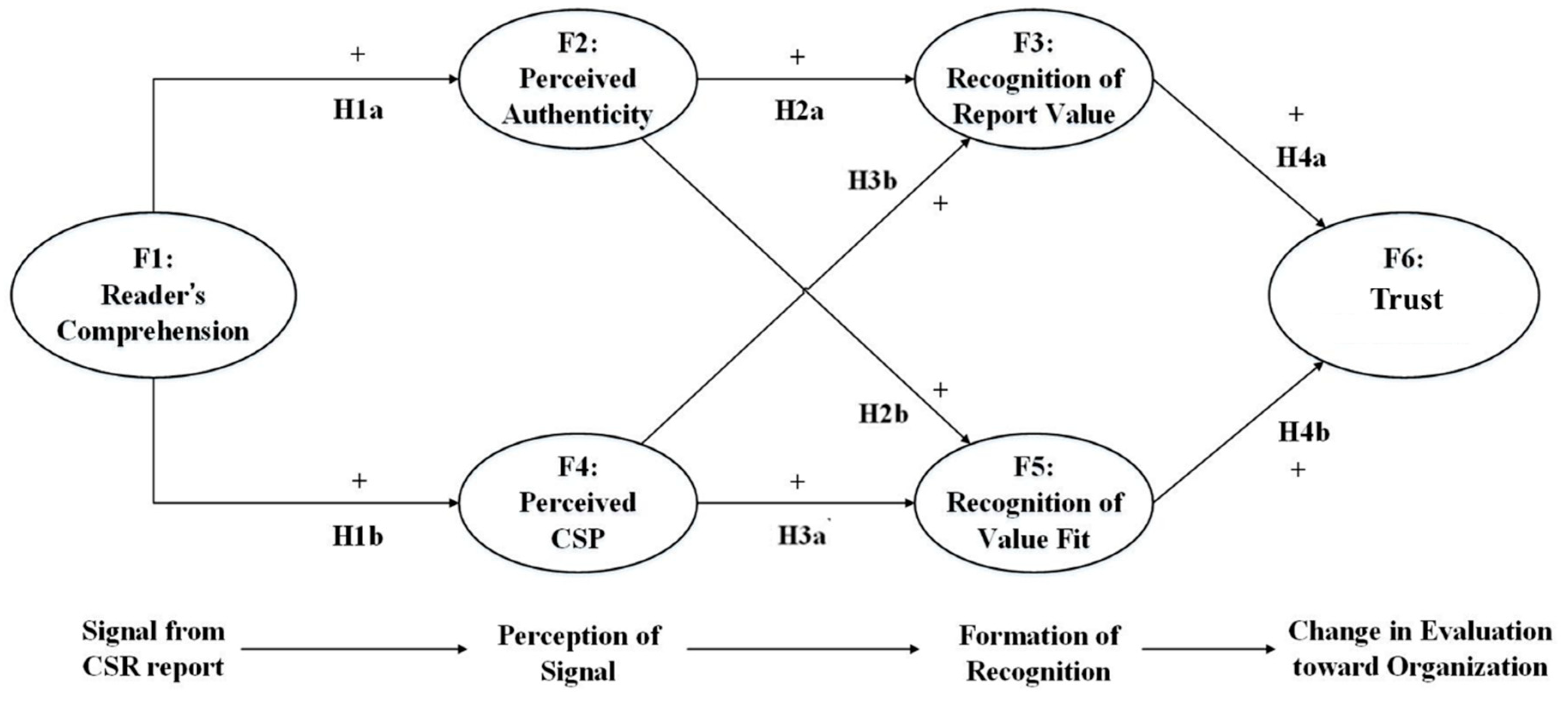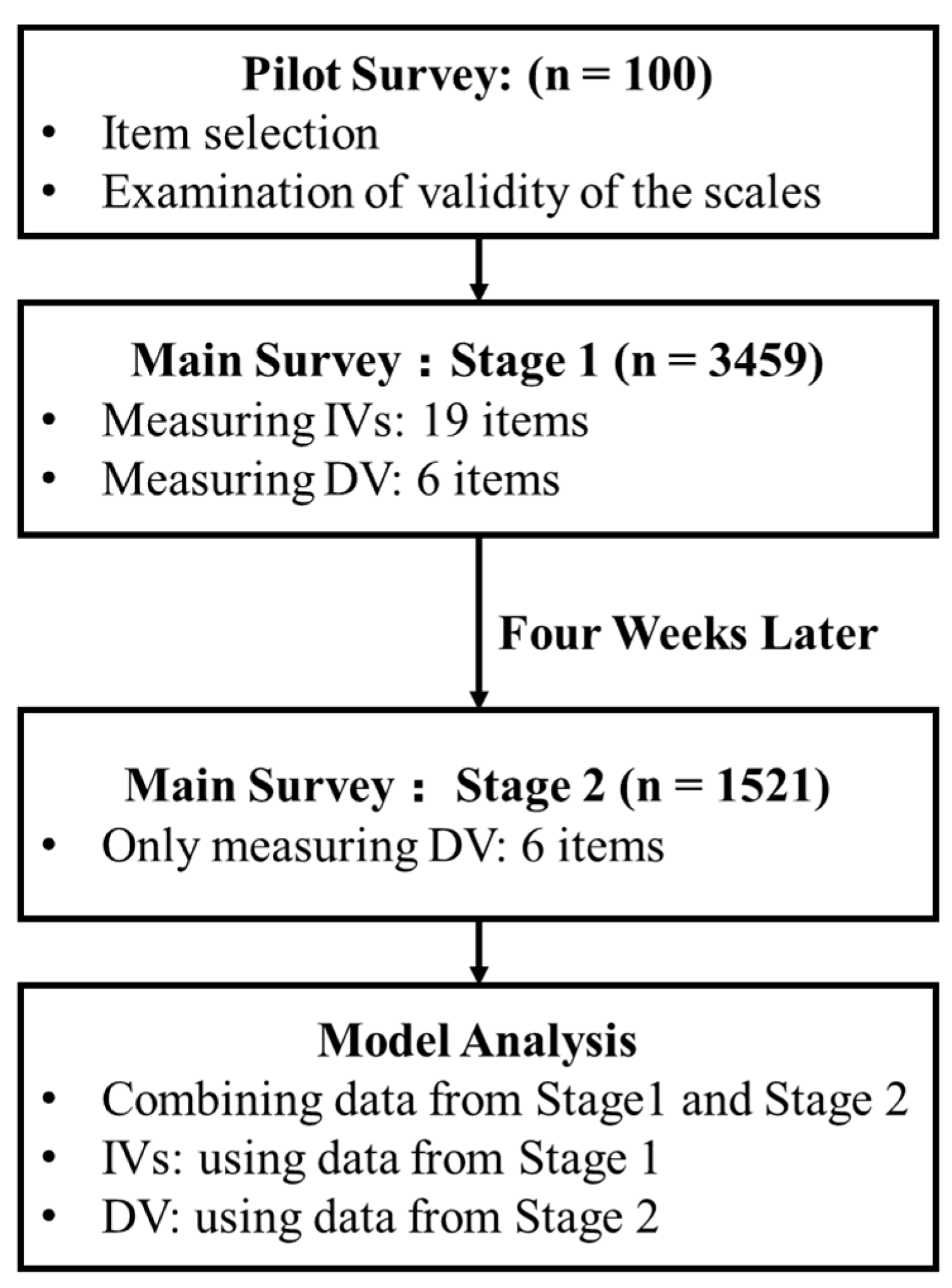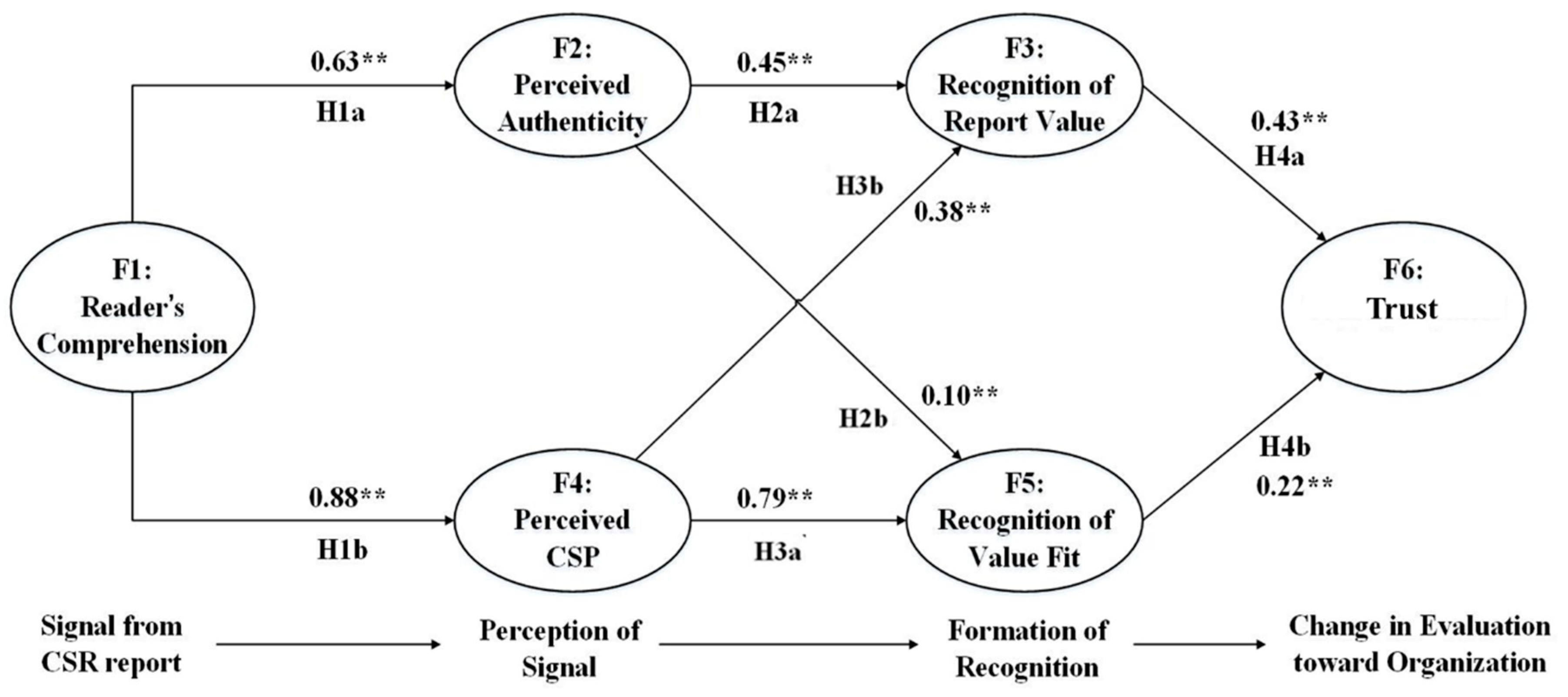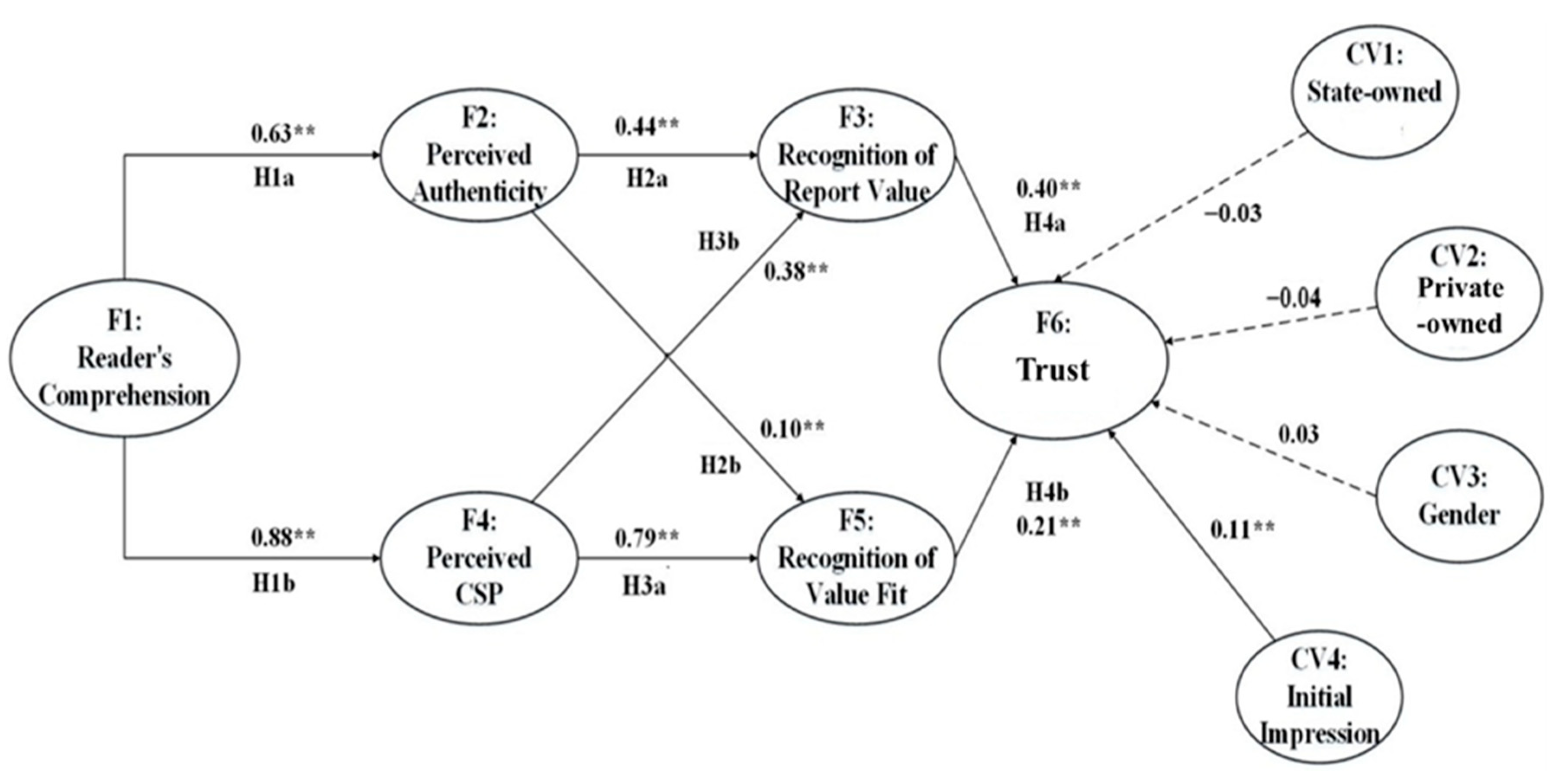The Formation of Reputation in CSR Disclosure: The Role of Signal Transmission and Sensemaking Processes of Stakeholders
Abstract
1. Introduction
2. Literature Review and Hypotheses
2.1. The Formation of Reputation in CSR Disclosure
2.2. Signal Transmission Based on CSR Comprehension
2.3. Sensemaking Processes and CSR Evaluation
2.4. The Effects on Reputation
3. Methodology
3.1. Sample and Data Collection
3.2. Procedures
3.3. Measures
3.4. Reliability and Validity of the Scales
3.5. Analyses of Measurement Model
4. Analysis and Results
4.1. Manipulation Checks
4.2. Structural Equation Model
4.3. Mediation Analysis
4.4. Robustness Analysis
5. Conclusions and Discussion
5.1. Theoretical Implications
5.2. Practical Implications
5.3. Limitations and Suggestions for Future Research
Author Contributions
Funding
Institutional Review Board Statement
Informed Consent Statement
Data Availability Statement
Conflicts of Interest
References
- Du, S.; Yu, K. Do Corporate Social Responsibility Reports Convey Value Relevant Information? Evidence from Report Readability and Tone. J. Bus. Ethics 2021, 172, 253–274. [Google Scholar] [CrossRef]
- Muslu, V.; Mutlu, S.; Radhakrishnan, S.; Tsang, A. Corporate Social Responsibility Report Narratives and Analyst Forecast Accuracy. J. Bus. Ethics 2019, 154, 1119–1142. [Google Scholar] [CrossRef]
- Dmytriyev, S.D.; Freeman, R.E.; Hörisch, J. The relationship between stakeholder theory and corporate social responsibility: Differences, similarities, and implications for social issues in management. J. Manag. Stud. 2021, 58, 1441–1470. [Google Scholar] [CrossRef]
- Vishwanathan, P.; van Oosterhout, H.; Heugens, P.P.; Duran, P.; Van Essen, M. Strategic CSR: A concept building meta-analysis. J. Manag. Stud. 2020, 57, 314–350. [Google Scholar] [CrossRef]
- Abd-El-Salam, E.M. Investigating loyalty through CSR: The mediating role of brand image and brand trust. J. Cust. Behav. 2020, 19, 253–280. [Google Scholar] [CrossRef]
- Zhang, L.; Shan, Y.G.; Chang, M. Can CSR Disclosure Protect Firm Reputation during Financial Restatements? J. Bus. Ethics 2021, 173, 157–184. [Google Scholar] [CrossRef]
- Kurpierz, J.R.; Smith, K. The greenwashing triangle: Adapting tools from fraud to improve CSR reporting. Sustain. Account. Manag. Policy J. 2020, 11, 1075–1093. [Google Scholar] [CrossRef]
- Xiao, Z.; Wang, Y.; Guo, D. Will Greenwashing Result in Brand Avoidance? A Moderated Mediation Model. Sustainability 2022, 14, 7204. [Google Scholar] [CrossRef]
- Li, Z.F.; Lu, X.; Wang, J. Corporate Social Responsibility and Goodwill Impairment: Charitable Donations of Chinese Listed Companies. Available online: https://ssrn.com/abstract=4337571 (accessed on 21 January 2023).
- García-Sánchez, I.M.; Hussain, N.; Khan, S.A.; Martínez-Ferrero, J. Do markets punish or reward corporate social responsibility decoupling? Bus. Soc. 2021, 60, 1431–1467. [Google Scholar] [CrossRef]
- Zhu, C.; Zeng, R.; Wang, R.X.; Xiao, Y. Corporate social responsibility and chief executive officer wrongdoing: A fraud triangle perspective. Corp. Soc. Responsib. Environ. Manag. 2023, 30, 874–888. [Google Scholar] [CrossRef]
- Gul, F.A.; Krishnamurti, C.; Shams, S.; Chowdhury, H. Corporate social responsibility, overconfident CEOs and empire building: Agency and stakeholder theoretic perspectives. J. Bus. Res. 2020, 111, 52–68. [Google Scholar] [CrossRef]
- Petrenko, O.V.; Aime, F.; Ridge, J.; Hill, A. Corporate social responsibility or CEO narcissism? CSR motivations and organizational performance. Strateg. Manag. J. 2016, 37, 262–279. [Google Scholar] [CrossRef]
- List, J.A.; Momeni, F. When corporate social responsibility backfires: Evidence from a natural field experiment. Manag. Sci. 2021, 67, 8–21. [Google Scholar] [CrossRef]
- Aguinis, H.; Glavas, A. What we know and don’t know about corporate social responsibility: A review and research agenda. J. Manag. 2012, 38, 932–968. [Google Scholar] [CrossRef]
- Guzzo, R.F.; Abbott, J.; Madera, J.M. A micro-level view of CSR: A hospitality management systematic literature review. Cornell Hosp. Q. 2020, 61, 332–352. [Google Scholar] [CrossRef]
- Clarkson, P.M.; Li, Y.; Richardson, G.D.; Vasvari, F.P. Does it really pay to be green? Determinants and consequences of proactive environmental strategies. J. Account. Public Policy 2011, 30, 122–144. [Google Scholar] [CrossRef]
- Moratis, L. Signalling Responsibility? Applying Signalling Theory to the ISO 26000 Standard for Social Responsibility. Sustainability 2018, 10, 4172. [Google Scholar] [CrossRef]
- Zerbini, F. CSR initiatives as market signals: A review and research agenda. J. Bus. Ethics 2017, 146, 1–23. [Google Scholar] [CrossRef]
- Connelly, B.L.; Certo, S.T.; Ireland, R.D.; Reutzel, C.R. Signaling theory: A review and assessment. J. Manag. 2011, 37, 39–67. [Google Scholar] [CrossRef]
- Weick, K.E. Sensemaking in Organizations; Sage: Thousand Oaks, CA, USA, 1995; Volume 3. [Google Scholar]
- Bing, T.; Li, M. Does CSR signal the firm value? Evidence from China. Sustainability 2019, 11, 4255. [Google Scholar] [CrossRef]
- Bae, S.M.; Masud, M.A.K.; Kim, J.D. A cross-country investigation of corporate governance and corporate sustainability disclosure: A signaling theory perspective. Sustainability 2018, 10, 2611. [Google Scholar] [CrossRef]
- Chen, Q.; Hu, M.; He, Y.; Lin, I.; Mattila, A.S. Understanding guests’ evaluation of green hotels: The interplay between willingness to sacrifice for the environment and intent vs. quality-based market signals. Int. J. Hosp. Manag. 2022, 104, 103229. [Google Scholar] [CrossRef]
- Newman, K.P.; Trump, R.K. Reducing skepticism about corporate social responsibility: Roles of gender and agentic-communal orientations. J. Consum. Mark. 2019, 36, 189–196. [Google Scholar] [CrossRef]
- Snow, C. Reading for Understanding: Toward an R&D Program in Reading Comprehension; Rand: Santa Monica, CA, USA, 2002. [Google Scholar]
- Guthrie, J.T.; Wigfield, A.; You, W. Instructional contexts for engagement and achievement in reading. In Handbook of Research on Student Engagement; Springer: Berlin/Heidelberg, Germany, 2012; pp. 601–634. [Google Scholar]
- Yoo, D.; Lee, J. The Effects of Corporate Social Responsibility (CSR) Fit and CSR Consistency on Company Evaluation: The Role of CSR Support. Sustainability 2018, 10, 2956. [Google Scholar] [CrossRef]
- Alcañiz, E.B.; Cáceres, R.C.; Pérez, R.C. Alliances between brands and social causes: The influence of company credibility on social responsibility image. J. Bus. Ethics 2010, 96, 169–186. [Google Scholar] [CrossRef]
- Song, B.; Dong, C. What do we know about CSR authenticity? A systematic review from 2007 to 2021. Soc. Responsib. J. 2023, 19, 525–548. [Google Scholar] [CrossRef]
- Jones, D.A.; Rupp, D.E. Social responsibility in and of organizations: The psychology of corporate social responsibility among organizational members. In The SAGE Handbook of Industrial, Work and Organizational Psychology: Managerial Psychology and Organizational Approaches, 2nd ed.; Ones, D.S., Anderson, N., Viswesvaran, C., Sinangil, H.K., Eds.; Sage: Thousand Oaks, CA, USA, 2018; Volume 3, pp. 333–350. [Google Scholar]
- Du, S.; Bhattacharya, C.B.; Sen, S. Maximizing business returns to corporate social responsibility (CSR): The role of CSR communication. Int. J. Manag. Rev. 2010, 12, 8–19. [Google Scholar] [CrossRef]
- Bebbington, J.; Larrinaga, C.; Moneva, J.M. Corporate social reporting and reputation risk management. Account. Audit. Account. J. 2008, 21, 337–361. [Google Scholar] [CrossRef]
- Lin-Hi, N.; Blumberg, I. The link between (not) practicing CSR and corporate reputation: Psychological foundations and managerial implications. J. Bus. Ethics 2018, 150, 185–198. [Google Scholar] [CrossRef]
- Mion, G.; Loza Adaui, C.R. Mandatory nonfinancial disclosure and its consequences on the sustainability reporting quality of Italian and German companies. Sustainability 2019, 11, 4612. [Google Scholar] [CrossRef]
- Johnson, D.; Grayson, K. Cognitive and affective trust in service relationships. J. Bus. Res. 2005, 58, 500–507. [Google Scholar] [CrossRef]
- Chai, J.C.Y.; Malhotra, N.K.; Alpert, F. A two-dimensional model of trust–value–loyalty in service relationships. J. Retail. Consum. Serv. 2015, 26, 23–31. [Google Scholar] [CrossRef]
- Sparr, J.L.; van Knippenberg, D.; Kearney, E. Paradoxical leadership as sensegiving: Stimulating change-readiness and change-oriented performance. Leadersh. Organ. Dev. J. 2022, 43, 225–237. [Google Scholar] [CrossRef]
- Yu, X.; Shen, Y.; Khazanchi, D. Swift trust and sensemaking in fast response virtual teams. J. Comput. Inf. Syst. 2022, 62, 1072–1087. [Google Scholar] [CrossRef]
- Mazutis, D.D.; Slawinski, N. Reconnecting business and society: Perceptions of authenticity in corporate social responsibility. J. Bus. Ethics 2015, 131, 137–150. [Google Scholar] [CrossRef]
- Alhouti, S.; Johnson, C.M.; Holloway, B.B. Corporate social responsibility authenticity: Investigating its antecedents and outcomes. J. Bus. Res. 2016, 69, 1242–1249. [Google Scholar] [CrossRef]
- Fiss, P.C.; Zajac, E.J. The symbolic management of strategic change: Sensegiving via framing and decoupling. Acad. Manag. J. 2006, 49, 1173–1193. [Google Scholar] [CrossRef]
- Wood, D.J. Corporate social performance revisited. Acad. Manag. Rev. 1991, 16, 691–718. [Google Scholar] [CrossRef]
- Jones, D.A.; Willness, C.R.; Madey, S. Why are job seekers attracted by corporate social performance? Experimental and field tests of three signal-based mechanisms. Acad. Manag. J. 2014, 57, 383–404. [Google Scholar] [CrossRef]
- Cable, D.M.; DeRue, D.S. The convergent and discriminant validity of subjective fit perceptions. J. Appl. Psychol. 2002, 87, 875. [Google Scholar] [CrossRef]
- Grabner-Kräuter, S.; Kaluscha, E.A. Empirical research in on-line trust: A review and critical assessment. Int. J. Hum.-Comput. Stud. 2003, 58, 783–812. [Google Scholar] [CrossRef]
- Mayer, R.C.; Davis, J.H.; Schoorman, F.D. An integrative model of organizational trust. Acad. Manag. Rev. 1995, 20, 709–734. [Google Scholar] [CrossRef]
- Tian, Z.; Wang, R.; Yang, W. Consumer responses to corporate social responsibility (CSR) in China. J. Bus. Ethics 2011, 101, 197–212. [Google Scholar] [CrossRef]
- Pallant, J. SPSS Survival Manual: A Step by Step Guide to Data Analysis Using SPSS for Windows (Versions 10 and 11): SPSS Student Version 11.0 for Windows; Open University Press: Milton Keynes, UK, 2001. [Google Scholar]
- Hu, L.T.; Bentler, P.M. Cutoff criteria for fit indexes in covariance structure analysis: Conventional criteria versus new alternatives. Struct. Equ. Model. Multidiscip. J. 1999, 6, 1–55. [Google Scholar] [CrossRef]
- James, L.R.; Mulaik, S.A.; Brett, J.M. A tale of two methods. Organ. Res. Methods 2006, 9, 233–244. [Google Scholar] [CrossRef]
- Jones, T.M.; Harrison, J.S.; Felps, W. How applying instrumental stakeholder theory can provide sustainable competitive advantage. Acad. Manag. Rev. 2018, 43, 371–391. [Google Scholar] [CrossRef]
- Ban, Q. The Quality of Corporate Social Responsibility Information Disclosure and Enterprise Innovation: Evidence from Chinese Listed Companies. Sustainability 2022, 15, 238. [Google Scholar] [CrossRef]
- Baier, C.; Göttsche, M.; Hellmann, A.; Schiemann, F. Too good to be true: Influencing credibility perceptions with signaling reference explicitness and assurance depth. J. Bus. Ethics 2022, 178, 695–714. [Google Scholar] [CrossRef]




| Demographics | Percentage | Demographics | Percentage |
|---|---|---|---|
| Gender | Source of firm information | ||
| Male | 42.9 | Official website | 32.3 |
| Female | 57.1 | Social network | 29.2 |
| Age | Newspaper | 9.1 | |
| 18–19 years | 27.2 | Professional magazine | 4.7 |
| 20–21 years | 54.3 | TV | 18.7 |
| 22–23 years | 15.1 | Self-observation | 5.9 |
| >23 years | 3.4 | Monthly family income | |
| Concern about firm | ≤2000 yuan | 15.7 | |
| No concern | 26.4 | 2001–6000 yuan | 56.4 |
| General concern | 51.2 | 6000–8000 yuan | 30.1 |
| Close concern | 22.4 | >10,000 yuan | 7.8 |
| Construct | Standardized Loadings | ||
|---|---|---|---|
| Cronbach’s Alpha | Composite Reliability | Average Variance Extracted | |
| Perceived authenticity | 0.82 | 0.82 | 0.60 |
| Recognition of report value | 0.84 | 0.74 | 0.59 |
| Perceived CSP | 0.94 | 0.94 | 0.67 |
| Recognition of value fit | 0.86 | 0.74 | 0.68 |
| Trust (Stage 1) | 0.90 | 0.90 | 0.60 |
| Trust (Stage 2) | 0.92 | 0.92 | 0.66 |
| Item | Stage 1 Loading | Stage 2 Loading |
|---|---|---|
| F1: Reader’s comprehension | ||
| 1. Do you understand what informative intention this CSR report is trying to convey (V1) | 0.63 | |
| F2: Perceived authenticity | ||
| 1. This CSR report reflects the unique factors of the firm (V2) | 0.61 | |
| 2. Compared with other CSR reports or materials, this CSR report gives a more authentic portrait of the firm (V3) | 0.67 | |
| 3. This CSR report can fully reflect the personality of the firm (V4) | 0.76 | |
| F3: Recognition of report value | ||
| 1. This CSR report can help me understand the main information of the firm better (V5) | 0.53 | |
| 2. The firm should issue this kind of CSR report regularly (V6) | 0.64 | |
| 3. This CSR report improves my recognition of the firm’s overall operating conditions (V7) | 0.75 | |
| 4. This CSR report increases my affection for the firm (V8) | 0.67 | |
| F4: Perceived CSP | ||
| 1. This firm gives back to its community (locally, nationally, and/or internationally) (V9) | 0.76 | |
| 2. This firm takes part in voluntary or charitable activities (V10) | 0.72 | |
| 3. This firm is active in helping its community (V11) | 0.76 | |
| 4. This firm tries to have a positive influence on its community (V12) | 0.80 | |
| 5. This firm has good environmental policies (V13) | 0.77 | |
| 6. This firm is concerned about environmental sustainability (V14) | 0.78 | |
| 7. This firm is trying to reduce its impact on the environment (V15) | 0.77 | |
| 8. This firm is an environmentally friendly firm (V16) | 0.76 | |
| F5: Recognition of value fit | ||
| 1. The things that I value in life are very similar to the things the firm values (V17) | 0.68 | |
| 2. What I value in my life is very identical to what the firm pays attention to (V18) | 0.67 | |
| 3. My personal values match the firm’s values and culture (V19) | 0.66 | |
| F6: Trust | ||
| 1. I think this firm has all the resources and conditions needed for performing social responsibility (V20) | 0.76 | 0.68 |
| 2. I think the awareness of this firm for social responsibility is thorough and comprehensive (V21) | 0.79 | 0.75 |
| 3. I think this firm has accumulated rich experience to fulfill its social responsibility in its specific field (V22) | 0.77 | 0.72 |
| 4. I think this firm has done well in the aspect of philanthropic work (V23) | 0.74 | 0.67 |
| 5. I think this firm has established the perfect social responsibility management system (V24) | 0.78 | 0.68 |
| 6. I think this firm will be determinate to perform its responsibility (V25) | 0.77 | 0.69 |
| Variable | M | SD | 1 | 2 | 3 | 4 |
|---|---|---|---|---|---|---|
| 1. Reader’s comprehension | 4.99 | 0.78 | ||||
| 2. Perceived authenticity | 4.91 | 0.90 | 0.32 ** | (0.77) | ||
| 3. Recognition of report value | 5.27 | 0.87 | 0.47 ** | 0.54 ** | (0.77) | |
| 4. Perceived CSP | 5.45 | 0.89 | 0.45 ** | 0.49 ** | 0.56 ** | (0.82) |
| 5. Recognition of value fit | 5.14 | 1.00 | 0.40 ** | 0.43 ** | 0.47 ** | 0.74 ** |
| 6. Trust (Stage 1) | 4.01 | 0.87 | 0.39 ** | 0.48 ** | 0.59 ** | 0.55 ** |
| 7. Trust (Stage 2) | 5.03 | 0.86 | 0.45 ** | 0.41 ** | 0.48 ** | 0.45 ** |
| 8. State-owned | 0.71 | 0.45 | −0.08 ** | −0.05 | −0.00 | −0.02 |
| 9. Private-owned | 0.14 | 0.34 | 0.06 * | 0.05 | 0.04 | 0.01 |
| 10. Gender | 0.62 | 0.48 | 0.02 | 0.02 | −0.01 | 0.06 * |
| 11. Initial Impression | 4.77 | 1.02 | 0.28 ** | 0.32 ** | 0.32 ** | 0.24 ** |
| Variable | 5 | 6 | 7 | 8 | 9 | 10 |
| 5. Recognition of value fit | (0.82) | |||||
| 6. Trust (Stage 1) | 0.46 ** | (0.77) | ||||
| 7. Trust (Stage 2) | 0.39 ** | 0.47 ** | (0.81) | |||
| 8. State-owned | −0.04 | −0.01 | −0.04 | |||
| 9. Private-owned | 0.02 | 0.03 | 0.01 | −0.64 ** | ||
| 10. Gender | 0.05 | 0.03 | 0.04 | 0.03 | −0.02 | |
| 11. Initial Impression | 0.24 ** | 0.30 ** | 0.28 ** | −0.16 ** | 0.12 ** | 0.00 |
| Variable | Stage 1 | Stage 2 | t-Test | |||
|---|---|---|---|---|---|---|
| M | SD | M | SD | F | 1 vs. 2 | |
| Item 1 | 4.28 | 1.14 | 5.19 | 1.05 | 10.77 ** | 21.34 ** |
| Item 2 | 4.02 | 1.09 | 5.03 | 1.02 | 6.94 * | 24.37 ** |
| Item 3 | 4.06 | 1.16 | 5.16 | 1.00 | 17.50 *** | 25.72 ** |
| Item 4 | 3.87 | 1.02 | 4.94 | 1.01 | 5.93 * | 26.24 ** |
| Item 5 | 3.77 | 1.05 | 4.94 | 0.99 | 7.49 ** | 27.71 ** |
| Item 6 | 3.93 | 1.03 | 4.95 | 1.04 | 4.15 * | 24.57 ** |
| Trust | 4.01 | 0.87 | 5.03 | 0.86 | 9.07 ** | 34.01 ** |
| Indirect Effects | BC 95% CI | ||
|---|---|---|---|
| Estimate | Lower Bound | Upper Bound | |
| Predictor: Reader’s Comprehension | |||
| Total indirect effect | 0.19 ** | 0.09 | 0.32 |
| Unique indirect effects through: | |||
| 1. [F1→F2] × [F2→F3] × [F3→F6] | 0.09 ** | 0.05 | 0.15 |
| 2. [F1→F2] × [F2→F5] × [F5→F6] | 0.00 | −0.00 | 0.01 |
| 3. [F1→F4] × [F4→F5] × [F5→F6] | 0.00 | −0.06 | 0.09 |
| 4. [F1→F4] × [F4→F3] × [F3→F6] | 0.10 ** | 0.05 | 0.16 |
| Hypothetic Pathway | Standardized Coefficient | |||
|---|---|---|---|---|
| Stated-Owned (n = 1085) | Private-Owned (n = 214) | Foreign (n = 222) | Full Sample (n = 1521) | |
| H1a: F1→F2 | 0.60 ** | 0.52 ** | 0.82 ** | 0.63 ** |
| H1b: F1→F4 | 0.88 ** | 0.97 ** | 0.82 ** | 0.88 ** |
| H2a: F2→F3 | 0.42 ** | 0.45 ** | 0.61 ** | 0.45 ** |
| H2b: F4→F3 | 0.44 ** | 0.37 ** | 0.13 ** | 0.38 ** |
| H3a: F2→F5 | 0.11 ** | 0.10 ** | 0.08 ** | 0.10 ** |
| H3b: F4→F5 | 0.78 ** | 0.81 ** | 0.82 ** | 0.79 ** |
| H4a: F3→F6 | 0.41 ** | 0.45 ** | 0.47 ** | 0.43 ** |
| H4b: F5→F6 | 0.22 ** | 0.20 ** | 0.21 ** | 0.22 ** |
Disclaimer/Publisher’s Note: The statements, opinions and data contained in all publications are solely those of the individual author(s) and contributor(s) and not of MDPI and/or the editor(s). MDPI and/or the editor(s) disclaim responsibility for any injury to people or property resulting from any ideas, methods, instructions or products referred to in the content. |
© 2023 by the authors. Licensee MDPI, Basel, Switzerland. This article is an open access article distributed under the terms and conditions of the Creative Commons Attribution (CC BY) license (https://creativecommons.org/licenses/by/4.0/).
Share and Cite
Xu, R.; Liu, J.; Yang, D. The Formation of Reputation in CSR Disclosure: The Role of Signal Transmission and Sensemaking Processes of Stakeholders. Sustainability 2023, 15, 9418. https://doi.org/10.3390/su15129418
Xu R, Liu J, Yang D. The Formation of Reputation in CSR Disclosure: The Role of Signal Transmission and Sensemaking Processes of Stakeholders. Sustainability. 2023; 15(12):9418. https://doi.org/10.3390/su15129418
Chicago/Turabian StyleXu, Ruiqian, Jinchen Liu, and Dongning Yang. 2023. "The Formation of Reputation in CSR Disclosure: The Role of Signal Transmission and Sensemaking Processes of Stakeholders" Sustainability 15, no. 12: 9418. https://doi.org/10.3390/su15129418
APA StyleXu, R., Liu, J., & Yang, D. (2023). The Formation of Reputation in CSR Disclosure: The Role of Signal Transmission and Sensemaking Processes of Stakeholders. Sustainability, 15(12), 9418. https://doi.org/10.3390/su15129418





